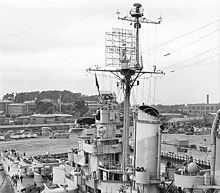The SG radar was a US Navy surface-search radar for large warships developed during the Second World War. The first operational set was installed aboard the heavy cruiser USS Augusta in April 1942.[1] It was the first Navy radar to use S-band (microwave) frequencies [2] and the first surface-search radar to be equipped with a plan position indicator (PPI), the ancestor of virtually all modern radar displays.
 SG (at the top of the mast) and SK-1 (below and to the left of the SG) radar antennas of USS Astoria | |
| Country of origin | United States |
|---|---|
| Introduced | 1942 |
| No. built | 955 |
| Type | Surface-search radar |
| Frequency | 3 GHz |
| PRF | 775, 800, or 825 |
| Beamwidth |
|
| Pulsewidth | 1.3–2 μs |
| RPM | 4, 8, or 12 |
| Range | 15 nmi (28 km; 17 mi) |
| Precision | 200 yd (180 m) |
| Power | 50 kW |
The radar was developed by Raytheon under the guidance of the MIT Radiation Laboratory and Naval Research Laboratory using the cutting-edge multicavity magnetron technology developed in Britain and brought to the US by the Tizard Mission.[2] The prototype was tested at sea aboard the destroyer USS Semmes in May 1941.[3] It saw extensive use during World War 2, particularly in the Pacific Theater, with about 1000 units produced during the war, and remained in service for about 2 decades.[2] Designed for installation on destroyers and larger ships to search for low-flying warplanes and surface ships, it achieved greatly improved surface coverage and detection of aircraft compared with previous lower frequency radars.[2] It also proved a superior navigation aid, making possible the detection of buoys and shoreline at night or bad weather.

Notes
editBibliography
edit- Brown, Louis (1999). A Radar History of World War II: Technical and Military Imperatives. Bristol and Philadelphia: Institute of Physics Publishing. ISBN 0-7503-0659-9.
- Friedman, Norman (1981). Naval Radar. London: Conway Maritime Press. ISBN 0-85177-238-2.
- Watson, Raymond C. Jr. (2009). Radar Origins Worldwide: History of Its Evolution in 13 Nations Through World War II. Trafford. ISBN 978-1-4269-2111-7.
Further reading
edit- "US Radar: Operational Characteristics of Radar Classified by Tactical Application". Naval History and Heritage Command. Retrieved 2022-02-18.